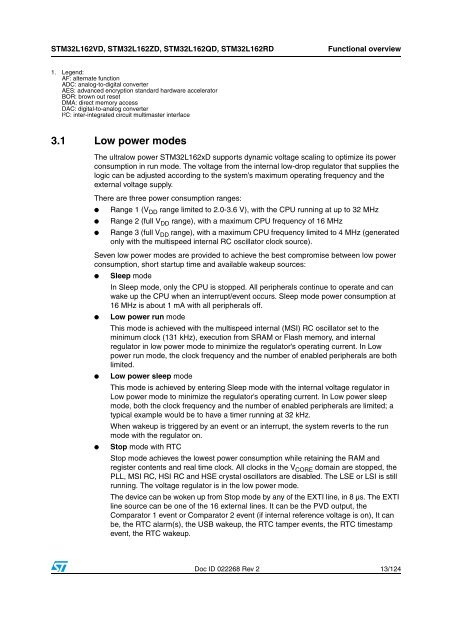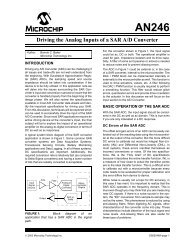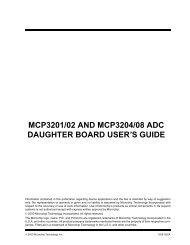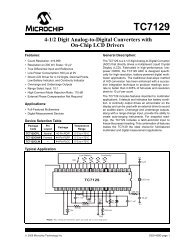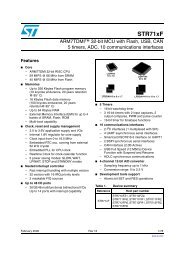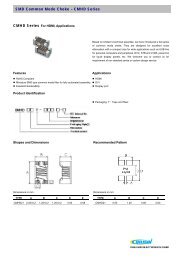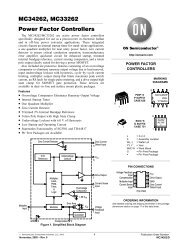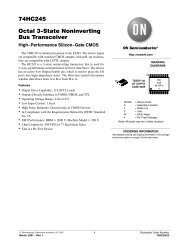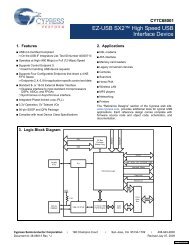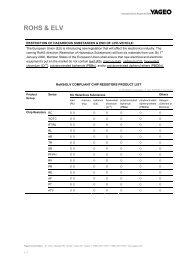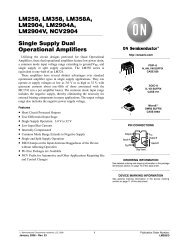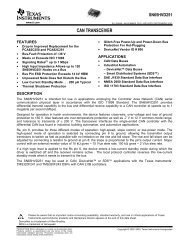Ultralow power ARM-based 32-bit MCU with 384 Kbytes Flash ... - Keil
Ultralow power ARM-based 32-bit MCU with 384 Kbytes Flash ... - Keil
Ultralow power ARM-based 32-bit MCU with 384 Kbytes Flash ... - Keil
- No tags were found...
Create successful ePaper yourself
Turn your PDF publications into a flip-book with our unique Google optimized e-Paper software.
STM<strong>32</strong>L162VD, STM<strong>32</strong>L162ZD, STM<strong>32</strong>L162QD, STM<strong>32</strong>L162RDFunctional overview1. Legend:AF: alternate functionADC: analog-to-digital converterAES: advanced encryption standard hardware acceleratorBOR: brown out resetDMA: direct memory accessDAC: digital-to-analog converterI²C: inter-integrated circuit multimaster interface3.1 Low <strong>power</strong> modesThe ultralow <strong>power</strong> STM<strong>32</strong>L162xD supports dynamic voltage scaling to optimize its <strong>power</strong>consumption in run mode. The voltage from the internal low-drop regulator that supplies thelogic can be adjusted according to the system’s maximum operating frequency and theexternal voltage supply.There are three <strong>power</strong> consumption ranges:● Range 1 (V DD range limited to 2.0-3.6 V), <strong>with</strong> the CPU running at up to <strong>32</strong> MHz● Range 2 (full V DD range), <strong>with</strong> a maximum CPU frequency of 16 MHz● Range 3 (full V DD range), <strong>with</strong> a maximum CPU frequency limited to 4 MHz (generatedonly <strong>with</strong> the multispeed internal RC oscillator clock source).Seven low <strong>power</strong> modes are provided to achieve the best compromise between low <strong>power</strong>consumption, short startup time and available wakeup sources:● Sleep modeIn Sleep mode, only the CPU is stopped. All peripherals continue to operate and canwake up the CPU when an interrupt/event occurs. Sleep mode <strong>power</strong> consumption at16 MHz is about 1 mA <strong>with</strong> all peripherals off.● Low <strong>power</strong> run modeThis mode is achieved <strong>with</strong> the multispeed internal (MSI) RC oscillator set to theminimum clock (131 kHz), execution from SRAM or <strong>Flash</strong> memory, and internalregulator in low <strong>power</strong> mode to minimize the regulator's operating current. In Low<strong>power</strong> run mode, the clock frequency and the number of enabled peripherals are bothlimited.● Low <strong>power</strong> sleep modeThis mode is achieved by entering Sleep mode <strong>with</strong> the internal voltage regulator inLow <strong>power</strong> mode to minimize the regulator’s operating current. In Low <strong>power</strong> sleepmode, both the clock frequency and the number of enabled peripherals are limited; atypical example would be to have a timer running at <strong>32</strong> kHz.When wakeup is triggered by an event or an interrupt, the system reverts to the runmode <strong>with</strong> the regulator on.● Stop mode <strong>with</strong> RTCStop mode achieves the lowest <strong>power</strong> consumption while retaining the RAM andregister contents and real time clock. All clocks in the V CORE domain are stopped, thePLL, MSI RC, HSI RC and HSE crystal oscillators are disabled. The LSE or LSI is stillrunning. The voltage regulator is in the low <strong>power</strong> mode.The device can be woken up from Stop mode by any of the EXTI line, in 8 µs. The EXTIline source can be one of the 16 external lines. It can be the PVD output, theComparator 1 event or Comparator 2 event (if internal reference voltage is on), It canbe, the RTC alarm(s), the USB wakeup, the RTC tamper events, the RTC timestampevent, the RTC wakeup.Doc ID 022268 Rev 2 13/124


